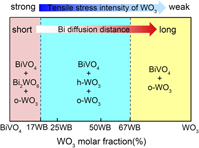Article contents
Microstructure evolution with composition ratio in self-assembled WO3–BiVO4 hetero nanostructures for water splitting
Published online by Cambridge University Press: 27 June 2017
Abstract

A series of self-assembled WO3–BiVO4 nanostructured thin films with 17, 25, 50, 67, and 100 mol% WO3 were grown on the (001) yttria-stabilized zirconia (YSZ) substrate by pulsed laser deposition method. The microstructures including crystalline phases, epitaxial relationship, interface structures, and chemical composition distributions were investigated by a combination of various electron microscopy techniques including scanning electron microscopy, transmission electron microscopy, and X-ray energy dispersive spectroscopy. The monoclinic BiVO4 formed the matrix, in which WO3 nanopillars were embedded with specific epitaxial relationships. In BiVO4-rich sample, orthorhombic Bi2WO6 was formed. However, metastable hexagonal WO3 phase and orthorhombic WO3 phase coexisted in other composite samples. The thin amorphous layer at the film/substrate interface indicated that the mismatch strain between films and substrate is released. The hydrostatic tensile strain due to thermal expansion mismatch between BiVO4 and WO3 as well as the diffusion of Bi into the WO3 stabilized the metastable h-WO3. A WO3–BiVO4 pseudobinary phase diagram was proposed based on the magnitude of the thermal expansion mismatch and the distance of Bi diffusion, which can be applied to design the microstructures of WO3–BiVO4 heterojunctions and optimize their photoelectrochemical properties.
Keywords
- Type
- Articles
- Information
- Copyright
- Copyright © Materials Research Society 2017
Footnotes
Contributing Editor: Sung-Yoon Chung
References
REFERENCES
- 12
- Cited by



